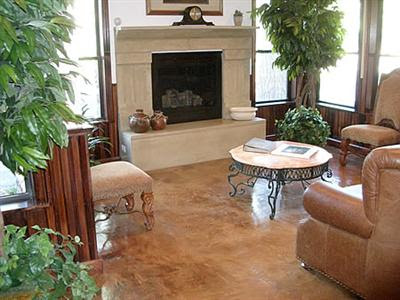
1. Design versatility.
Typically, interior concrete floor slabs have been hidden under other flooring materials such as carpet, hardwood, vinyl or ceramic tile. But why waste resources and money to add another layer of flooring when you can simply leave the concrete exposed? Decorative techniques such as coloring, staining, stamping, stenciling and polishing give unlimited design versatility, allowing you to create floors that mimic more traditional materials, such as tile or slate, or custom design a look that's totally unique (read more about decorative concrete flooring options).
2. Energy efficiency.
Because of their thermal mass and ability to retain heat, concrete floors are ideal for passive solar home designs. When homes are built to take advantage of solar radiation entering through windows in the winter months, concrete floors will absorb the heat from the direct sunlight and release the stored heat as needed at night to keep rooms warmer. Conversely in the summer and in hot climates, concrete floors shielded from the sun will stay cool longer and can actually help lower air-conditioning costs.
3. Easier breathing.
Concrete floors are a healthier alternative to wall-to-wall carpeting, especially for people with allergies or a sensitivity to chemicals. In fact, when it comes to poor indoor air quality, carpeting can be one of the worst offenders.
4. Economy.
An exposed concrete floor is often an economical alternative to other finish solutions such as hardwood flooring and tile. For new residential construction or commercial projects with site-cast concrete floor slabs, choosing to leave the concrete floors exposed can save big money over the life of the building. First, you don't have to buy and install an additional floor covering to put on top of the floor slab. In addition, the durability and low maintenance needs of concrete flooring will save you the recurring maintenance and replacement costs associated with less-enduring flooring materials, such as carpet and vinyl tile.
5. Durability and resource conservation.
When properly installed and sealed (see Sealing Colored Concrete), a decorative concrete floor should last a lifetime and will never need replacement. Few flooring materials can boast this same longevity. Another way concrete floors minimize waste: The fresh concrete that goes into a floor slab is manufactured at a local ready-mix plant in the quantities needed for each project. This also saves on the energy required to transport a factory-made product such as tile or carpet from the plant, to the distributor and eventually to your home.
http://www.atlanticcoastconcrete.net
